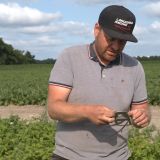
Smarter irrigation in France, Zeeland and Texel
For growers water is both friend and foe. To tip the balance in the right direction, several initiatives have been developed in the field of drip irrigation in recent years. Some use groundwater, others collect rainwater in a basin. And on Texel, one grower uses freshwater stored underground. All are convinced by these smarter irrigation methods
With Dutch growers also facing ‘French conditions’ more often, such as warmer weather and having fewer chemicals at their disposal, it’s a good idea to see how they are coping. Henri Stopin, Research & Development Engineer at HZPC France, clarifies: “French and Dutch growers learn together: The Dutch are frontrunners when it comes to efficient growing, we learn from that, and here in France we are more likely to be confronted with certain conditions. Although it’s not possible to replicate it exactly in the Netherlands, it can lead to new insights for Dutch growers.”
70 mm additional water needed
“France has always been warmer than the Netherlands,” Henri continues. “Yet we also see that the weather is changing. Our seed potatoes now need about 70 mm of extra water annually. In addition, we have fewer chemicals at our disposal, which challenges us to devise other solutions.” Such as the use of straw, which is now also increasing in popularity in the Netherlands to prevent virus transmission by aphids, is an initiative from France.
Henri: “We are challenged by the phenomenon of water scarcity particularly in the summer months. During that period, there is a palpable struggle between citizens, farmers and industry. If you are not allowed to wash your car but see a large water cannon shooting litres of water across a potato field further down the road, it can result in irritation. It means that growers in France increasingly have to demonstrate that their irrigation is sustainable and efficient. And drip irrigation plays a major role in that regard.”
Drip irrigation in France
To solve the irrigation problems in France, they started a drip irrigation demo field in 2022. Henri: “In 2023, we went on to organise a number of grower meetings on this theme. In association with supplier Netafim, since drip irrigation is not HZPC’s core business. And our experience is that growers can definitely use some advice when they start working with it, otherwise they might not get enough return on their investment.”
“Growers soon realised the benefits offered by drip irrigation. Especially because yields also increased significantly, by between 15 and 20%. Moreover, it reduces the degree of fluctuation and they see more seed potatoes in the right sizes. Both of which are obviously better for business.


“Growers also save on the number of times they have to spray the crop. Because the leaves don’t get wet, they are less susceptible to Phytophthora. In addition, growers no longer have to go out at night to move the water cannon. They control the drip irrigation with their smartphones. However, more time is needed for the preparation, which requires manpower.”
During that period, there is a palpable struggle between citizens, farmers and industry.
Drip irrigation pioneers
Filip and Teunike van’t Hof from Stavenisse first applied drip irrigation to their most difficult crop some eight years ago: mini tubers. Teunike: “At the time, there weren’t many people using drip irrigation in the open field so we designed a system ourselves.” Filip: “We were already convinced after the first year, even though we didn’t yet feel that we were really doing anything special. But the benefits in terms of yield, as well as the right sizes, were obvious right away. We started with one hectare. Afterwards, we gradually invested in more machinery and materials.”
Moisture proved to be a determining factor. Filip: “Even in places where we usually had a yield of ‘just’ 25 tonnes per hectare, drip irrigation increased it to 45 tonnes.” Which is now Filip and Teunike’s average yield. However, this is not only due to drip irrigation, it is mainly down to the addition of fertigation.
Fertigation is the next step
Another step to increase growth in addition to drip irrigation is fertigation. It enables you, for example, to add fertiliser via the same drip hoses. Filip and Teunike introduced it about four years ago. Teunike: “It allows us to get more out of the system, and work more efficiently. Because with fertigation, you add fertiliser to the plant when it needs it most.” “Moreover, it results in far less nitrogen leaching out. And that’s going to be an even bigger problem than we might sometimes think at the moment,” Filip adds.
In 2025, Filip and Teunike are irrigating some 60 hectares of land with drip hoses. Through which they administer about 60 mm on 15 separate watering sessions on an annual basis. Filip: “We don’t have any more water, otherwise we’d have done more. Our basin can hold about 5,000 cubic metres of water, which is collected via the roofs of our sheds. It’s not enough for an entire growing season. Therefore, we have the option of supplementing it with freshwater sources.”
Never too late
Manpower is an issue though for Filip and Teunike. “Labour is a challenge, which is why, for example, we are now investigating a way to automatically cut irrigation hoses. That saves precious time,” Filip explains. “But, in our opinion, the advantages far outweigh the disadvantages. You can only use a cannon when there is no wind. Moreover, you never have to wait for a shower: you are never too late.” Teunike: “Plants always get the right amount of water. As a result, we no longer see growth cracks either. It means you also have less work to do in the barn.”
Growers are entrepreneurs. And investments are determined based on risk assessments. At Van’t Hof, they calculated that their investment was definitely feasible. Filip: “Our cost for drip irrigation is 1,500 euros per hectare, which includes labour. The current seed potato price means it is feasible. Do the math, with an extra yield of 10 tonnes per hectare.”
Texel’s water problems
On Texel, they also rely on irrigation. The problem is that they lack freshwater sources: the salinity is too high. Nevertheless, grower Mark Slot, along with other stakeholders, wanted to explore how to optimally control the way moisture is added to his seed potato crop. To this end, he works with, among others, the province of North Holland, LTO Noord and Acacia Water, an independent consultancy working on global water issues. Together, they started the Sweet Future Texel (Zoete Toekomst Texel) project, which will run for three years at two locations to test whether rainwater can be stored in the ground, instead of pumping excess rainwater back into the Wadden Sea.
Texel is the ideal place to research this issue. Because here irrigation is not an option and farmers are entirely dependent on rainwater. Mark: “Acacia knew from experience that it is possible to store freshwater underground, provided the soil is suitable.
After conducting some research, the consultancy concluded that the soil is indeed suitable. Rainwater reaches the underground storage via drainage pipes in the fields. Before the water is pumped into the ground, any residues of crop protection agents that have leached into it are filtered out. Mark: “This year we have stored 20,000 m3 of water, but in theory, the soil offers endless capacity. “The amount of water we actually store depends on the amount of rainfall, the number of drainage pipes we connect to the system and the capacity of the filter that filters out the crop protection agents.”
Mark: “The idea behind the system is simple: in autumn and winter, there is enough rainfall, but we cannot use it. If we can store it, we’ll have enough for the summer. Fresh water reaches the potato fields thanks to ‘level-controlled drainage’, where water is pumped from the underground storage to the fields. I can configure the desired water level on the computer. So far, this method of irrigation provides a financial yield increase of 10-30%. However, the operation is challenging every now and then. Moreover, due to the crop rotation plan, you can only grow seed potatoes in the field with level-controlled drainage once every three or four years. That’s why I have recently been exploring drip irrigation.
This year, our underground storage was filled with 20,000 cubic metres of water.

From Texel to Stavenisse
“Did you also talk to Van’t Hof?” asks Mark Slot. “Oh, I was there the other day. I came across them online when I was looking for more information on drip irrigation. However, Stavenisse is not exactly around the corner, but I stopped by when I was in the area the other day.”
Mark wanted to know more about drip irrigation. And who better to ask than someone who has been working with it for eight years? Mark: “With level-controlled drainage, it takes a relatively long time to replenish the level; draining it is much faster. But suppose there is a downpour with 20 mm of rainwater predicted and you temporarily turn off the system, it will take a very long time to replenish the level if the downpour blows over. So I want to see if we can use the freshwater storage to irrigate with drip hoses. To gain even more control over the growth of my seed potatoes. I’m starting this year with one hectare.”
Hoses on a ridge or bed
Drip irrigation - and fertigation - can be achieved with different types of hoses. Whereas Henri has had a good experience with high-quality hoses that last ten years but are more expensive to buy, Van’t Hof works with new hoses every year. Mark Slot is also going to work with one-year hoses first.
Filip: “With one-year hoses, we are guaranteed that everything is always in good order. We mill them in a separate pass. We have pipes on the cultivator that insert the hose into the ground. They are positioned at the top of the ridge, where we plant our mini tubers. That part of the ridge is usually drier, but thanks to the drip irrigation, the ridge stays moist, AND cool, which reduces the stress on the plants.”
“High-quality hoses don’t need to be milled,” explains Henri. “They are resistant to the effects of the weather (like the sun), animals (such as birds) and it saves a lot of plastic waste. That’s our preference. In France, we lay the hoses on the beds, rather than on or between the ridges. A bed consists of three rows of potatoes and they place two hoses between the rows. But that type of bed is often less suitable for Dutch growers.”
Consequently, everyone looks at developments concerning irrigation in relation to their particular environment and situation. But it is obvious that important steps are being taken. And above all, everyone, from Texel, to Stavenisse and France, is convinced of the usefulness and necessity of smart irrigation.






